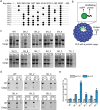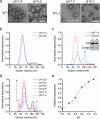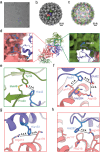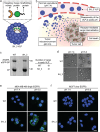A pH-Responsive Virus-Like Particle as a Protein Cage for a Targeted Delivery
- PMID: 37966427
- PMCID: PMC11469083
- DOI: 10.1002/adhm.202302656
A pH-Responsive Virus-Like Particle as a Protein Cage for a Targeted Delivery
Abstract
A stimuli-responsive protein self-assembly offers promising utility as a protein nanocage for biotechnological and medical applications. Herein, the development of a virus-like particle (VLP) that undergoes a transition between assembly and disassembly under a neutral and acidic pH, respectively, for a targeted delivery is reported. The structure of the bacteriophage P22 coat protein is used for the computational design of coat subunits that self-assemble into a pH-responsive VLP. Subunit designs are generated through iterative computational cycles of histidine substitutions and evaluation of the interaction energies among the subunits under an acidic and neutral pH. The top subunit designs are tested and one that is assembled into a VLP showing the highest pH-dependent structural transition is selected. The cryo-EM structure of the VLP is determined, and the structural basis of a pH-triggered disassembly is delineated. The utility of the designed VLP is exemplified through the targeted delivery of a cytotoxic protein cargo into tumor cells in a pH-dependent manner. These results provide strategies for the development of self-assembling protein architectures with new functionality for diverse applications.
Keywords: computational design; pH-responsive assembly; targeted delivery; virus-like particle.
© 2023 The Authors. Advanced Healthcare Materials published by Wiley-VCH GmbH.
Conflict of interest statement
The authors declare no conflict of interest.
Figures






References
-
- Lee E. J., Lee N. K., Kim I.‐S., Adv. Drug Delivery Rev. 2016, 106, 157. - PubMed
-
- Estrada L. H., Chu S., Champion J. A., J. Pharm. Sci. 2014, 103, 1863. - PubMed
-
- Herrera Estrada L. P., Champion J. A., Biomater. Sci. 2015, 3, 787. - PubMed
-
- Edwardson T. G. W., Mori T., Hilvert D., J. Am. Chem. Soc. 2018, 140, 10439. - PubMed
Publication types
MeSH terms
Substances
Grants and funding
LinkOut - more resources
Full Text Sources

